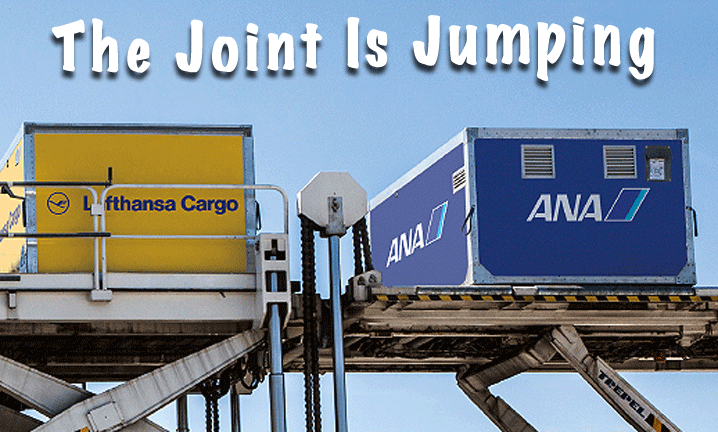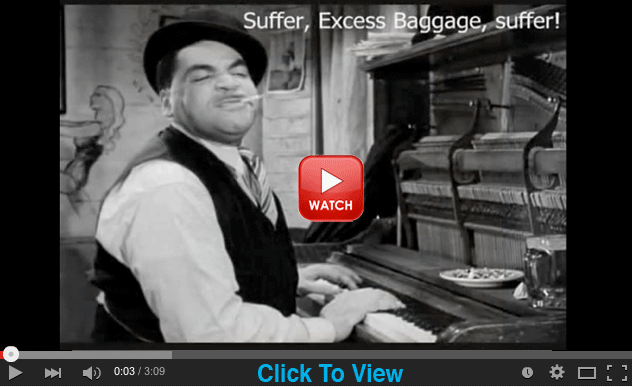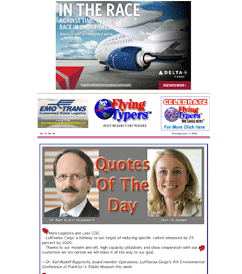| 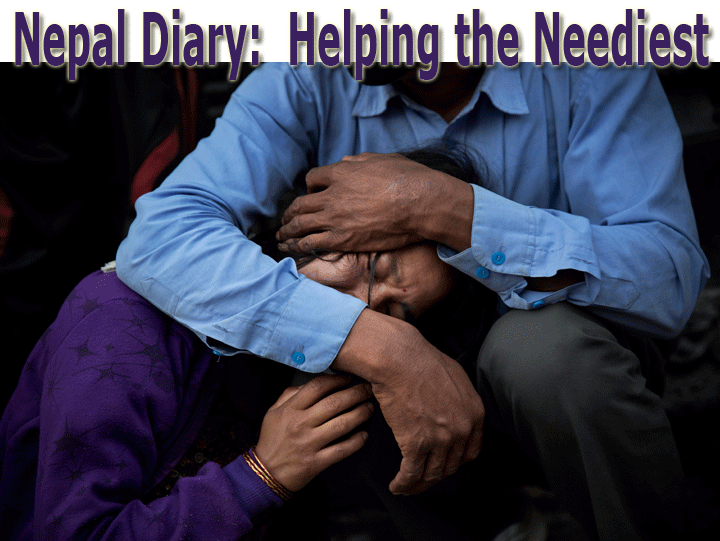
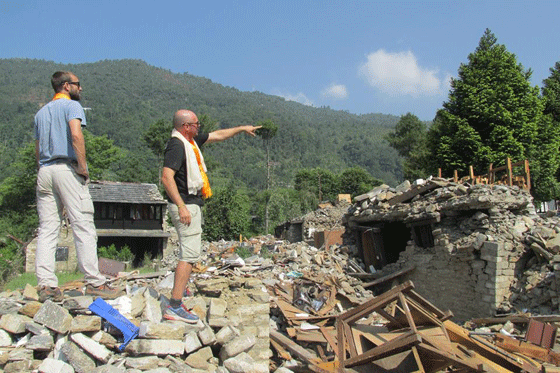 (FlyingTypers’
Asia/Pacific Editor-in-Chief SkyKing has spent the
majority of the past six weeks in Nepal covering the
story of the devastating earthquakes. He has also
become part of the story, raising money to help people
in the stricken nation. (FlyingTypers’
Asia/Pacific Editor-in-Chief SkyKing has spent the
majority of the past six weeks in Nepal covering the
story of the devastating earthquakes. He has also
become part of the story, raising money to help people
in the stricken nation.
Along the way, Sky has
filed an emotional, startling, and fact-filled dossier
of stories that we have faithfully sent out to you,
dear readers.
Now Sky (he is the guy
in the pictures wearing white shorts) tells of his
fundraising efforts and describes just how much it
meant when many of us in air cargo dug deep into our
pockets and hearts to send some relief to people in
bind far worse than most can imagine. We add our ‘thanks
for the lift’ to everyone who followed this
remarkable story and sent their support.)
Thanks so much to all
of you for all your financial support and encouragement
for Suman’s Story – Direct Aid for Nepal.
https://www.facebook.com/sumansstory
We’ve had the
craziest, most rewarding, humbling, saddest, and sheer
knackering three days I’ve ever experienced.
The funds you all gave
have helped hundreds of families—I know I’m
supposed to be a journalist but I really can’t
express how grateful I am for all your support.
Here’s the best
summary of how and where your money has been spent
I can summon in my exhausted, dust-cloaked state .
. .
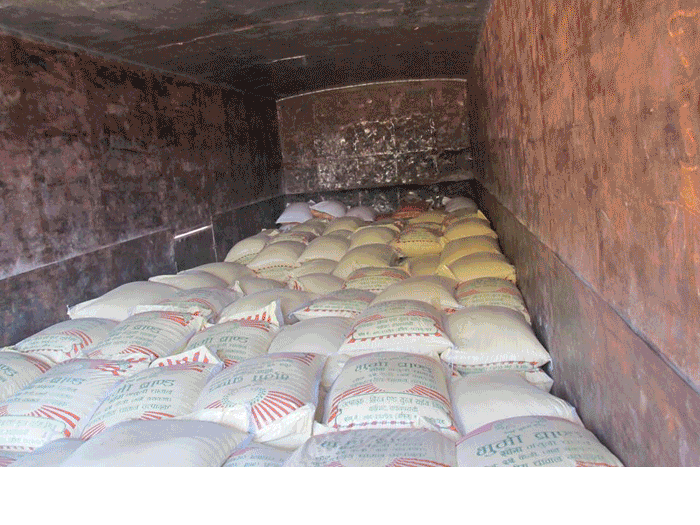 |
Day
1: We delivered 586 food packs to Palchok—one
per family.
Thanks to your efforts
and those of Tariq and the guys at Bye Bye Plastic
Bags, with a final delivery of rice Palchok will now
be able to see out the monsoon safely.
We also have the groundwork
in place to pay for and supply a medical clinic there,
more of which we will report later.
The chicken farm that
will provide the village with a collective income
is also progressing well—good idea, Tariq Batanoni
and Bye Bye Plastic Bags!
Day 2 and 3: Suman and
his team identified a string of villages far to the
northeast of Kathmandu that had not received any aid
since the April 25 earthquake devastated large parts
of the country and left hundreds of thousands of people
homeless and without access to food or medical aid.
Considering how badly their own lives have been affected
by the quakes, to set off to a remote part of the
country to help others was an act of extraordinary
selflessness by the villagers of Palchok and their
friends—my admiration for their bravery, organization
skills, humor under duress, and indefatigability has
no limits.
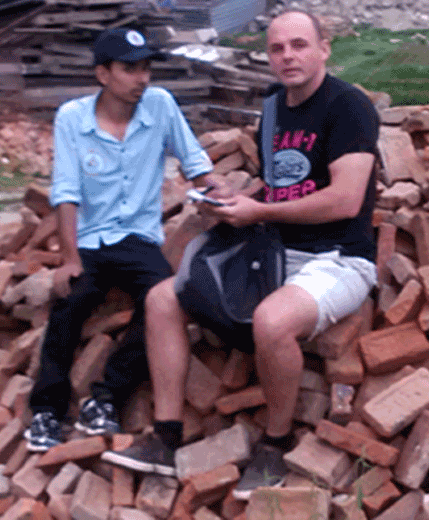
 I'm
fine, back home from Nepal as you read this—at
least I got to leave. I'm
fine, back home from Nepal as you read this—at
least I got to leave.
It was slightly
overwhelming and very hard work.
Village after village
decimated. The bigger towns looked like they'd
been hit by mortars.
Rubble everywhere,
but some buildings absolutely fine and the ones
nearby collapsed or leaning horribly.
Lots of people living
with no shelter or under a tarpaulin.
Very proud nation
with everyone trying to do their best though,
and always very generous.
 Lovely
people and a beautiful country! Lovely
people and a beautiful country!
—SkyKing |
They
really are the heroes in all this.
Take a bow:
Suman Khadka, 19
Ramesh Khadka, 29
Pawan Karki, 19
Arjun Khadka, 41
Mahendra Mijar, 21
Suman and the guys organized
for an early pick up of more than 250,000kg of rice
to be loaded into two trucks.
Unfortunately, the bloke
who was supposed to open the rice shop for loading
failed to turn up.
By the time he did,
time was running short. When we did finally get loaded
and underway it quickly emerged that one of the truck
drivers was new to driving on Nepal’s treacherous
roads—he hit two bikes in the first ten kilometers
before we even reached the mountains.
Luckily no one was injured,
but a new driver was required.
Unfortunately this also
meant getting a new truck and transporting 400 sacks
of 30kg rice between them.
Seven hours later, traveling
along a single track mountain road through town after
town, where most of the houses were rubble and people
were sleeping in makeshift tents, Paul, Suman’s
team of seven, and I arrived at our ‘hotel’—a
communal tarpaulin shelter where we all shared beds
or slept on tables.
Our hosts had previously
owned a thriving hotel in Jiri, but when this crumbled
they were left homeless.
We were all incredibly
grateful just to have somewhere covered to sleep,
but the welcome we got and hospitality received were
wonderful.
The next day was supposed
to be simple. We were to visit three villages and
deliver 30kg rice bags to 800 families, enough to
feed each family for 2-3 weeks.
But this is Nepal and
nothing is simple. After arranging and distributing
our first two drops, our final village was ‘just
on the other side of the valley.’
We took a shortcut.
The shortcut took 2.5
hours along a mountain track that was like driving
along a riverbed with sheer drops on either side.
We don’t think we covered more than ten miles
and for the most part it was faster to walk while
our heroic driver maneuvered our 4x4 (but with only
two of the wheels working) with the sort of control
that only the most skilled Nepalese mountain specialist
could manage with any safety. We honestly owe him
our lives.
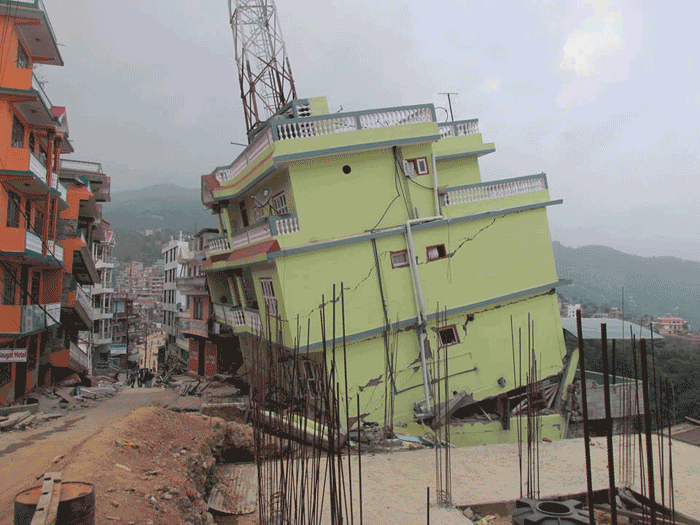
The journey was worth
it, though. When we arrived at Chyama the entire village
had converged to welcome us. We were presented with
garlands by all the kids and, after a round of speeches,
we started distributing 400 30kg rice sacks using
a fair and orderly system set up by Suman and the
village head.
Chyama has 800 families,
8 schools, and one clinic.
For most of the last
six weeks it has been inaccessible.
Indeed, the UN’s
website says it still is, so we really were heading
off into the unknown.
The village leader explained
that 95% of the buildings had been destroyed on April
25 and everyone was sleeping outdoors.
One aid delivery had
reached the village over the last six weeks but what
it had provided was totally inadequate.
When the rains trigger
more landslides, Chayama will be totally inaccessible
again.
The gratitude of the
village was humbling in the extreme and we all left
feeling overwhelmed by the amazing welcome we had
received and guilty there was not more we could do.
The village head said
the rice we delivered could be the difference between
life and death in the coming weeks for many of the
poorest families.
They are not even thinking
about rebuilding yet, just survival.
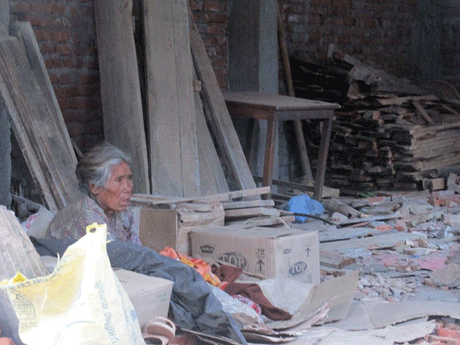 Today
we will help one poor old lady who, due to Nepal’s
Byzantine land ownership and tenancy system, has been
left with no food, shelter, or means to feed herself.
Because she was a tenant, any government relief must
go to the landlord. Today
we will help one poor old lady who, due to Nepal’s
Byzantine land ownership and tenancy system, has been
left with no food, shelter, or means to feed herself.
Because she was a tenant, any government relief must
go to the landlord.
Because her old house
no longer exists, according to the rules she is not
eligible for government help because she has no fixed
abode.
That’s Nepalese
bureaucracy for you! In effect she is caught in a
tragic Catch 22 situation that has rendered her a
non-person.
With the money we still
have left, Suman and his team will arrange for a shelter
to be built for her and supply her with food for the
coming months.
Updates on how this
project proceeds will follow.
Thanks so much to all
of you who have contributed.
I know there are many
great causes out there but the money you have spent
through ‘Suman’s Story’ has empowered
Nepalese people to help their families and some of
the most impoverished villages in the country. We
had no overhead and paid our own costs so every penny
has reached those who need it most.
For myself, Paul Winslow,
Suman, and the guys, this has been a crazy adventure
none of us will ever forget.
The thanks we have received
has been impossibly humbling and left me with a sense
that there is far more we can still achieve in Nepal
by empowering Suman and his team to continue their
great works.
Paul, Tariq, Bye Bye
Plastic Bags, and I have plans to help set up a permanent
clinic in Palchok as the first step to rebuilding
the town.
But for this we will
need more funding.
We will release details
shortly of how we will achieve this and what it will
cost. But for now, thanks again to you all from the
bottom of my heart!
SkyKing
|









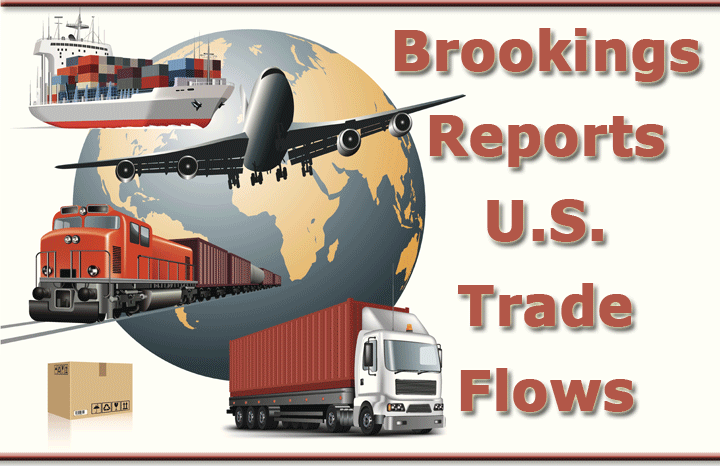



 (FlyingTypers’
Asia/Pacific Editor-in-Chief SkyKing has spent the
majority of the past six weeks in Nepal covering the
story of the devastating earthquakes. He has also
become part of the story, raising money to help people
in the stricken nation.
(FlyingTypers’
Asia/Pacific Editor-in-Chief SkyKing has spent the
majority of the past six weeks in Nepal covering the
story of the devastating earthquakes. He has also
become part of the story, raising money to help people
in the stricken nation.


 Today
we will help one poor old lady who, due to Nepal’s
Byzantine land ownership and tenancy system, has been
left with no food, shelter, or means to feed herself.
Because she was a tenant, any government relief must
go to the landlord.
Today
we will help one poor old lady who, due to Nepal’s
Byzantine land ownership and tenancy system, has been
left with no food, shelter, or means to feed herself.
Because she was a tenant, any government relief must
go to the landlord.  Vital
Views 1975-2015
Vital
Views 1975-2015 
